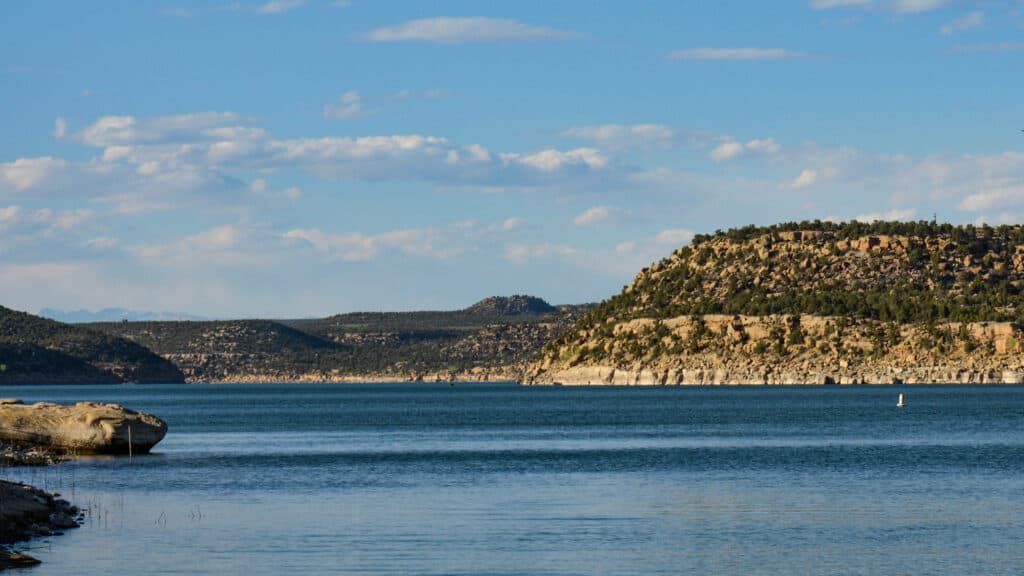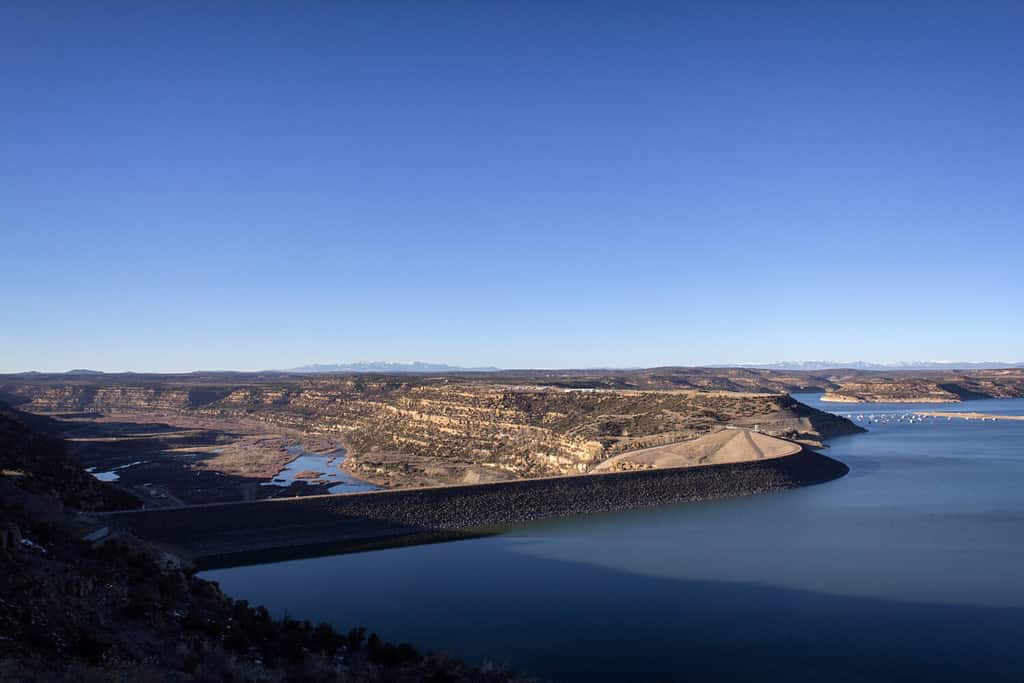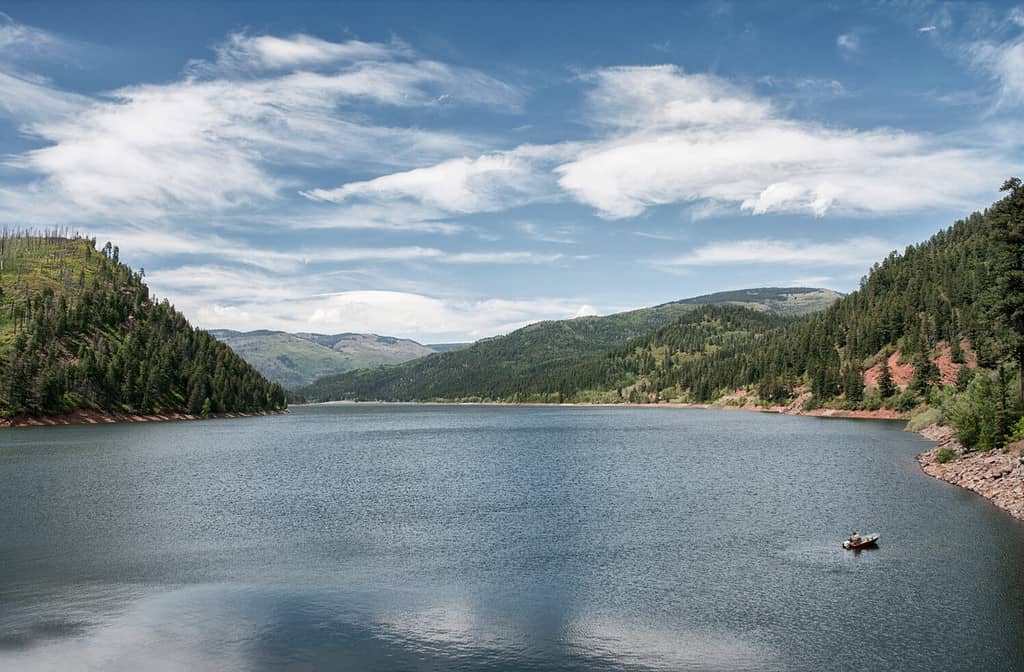Navajo Lake is located in the southwestern part of the United States, primarily in New Mexico. The lake is considered the second-largest lake in New Mexico and offers tons of recreational activities for visitors. Interestingly enough, the original purpose of this beautiful lake was not to simply have fun. Instead, it was originally constructed as a means for water storage and irrigation. The history behind this lake is incredibly fascinating. Today it has become a popular destination for fishing, swimming, and more! So are you interested in learning about Navajo Lake? Discover everything there is to know about this large reservoir that extends into two states and offers lots of fun activities for everyone to enjoy.
Navajo Lake Location

The largest portion of Navajo Lake is primarily located in New Mexico with a small portion extending into Colorado.
©Brenda Landdeck/Shutterstock.com
The majority of Navajo Lake is concentrated in the northwestern part of New Mexico. However, there is also a small portion of the lake that extends into southern Colorado. The lake itself is classified as a reservoir. It is situated in the San Juan River Basin and is also part of the larger San Juan River system. This river system actually runs through several states which include Colorado, New Mexico, Utah, and Arizona. The lake is also a part of Navajo Lake State Park. As a part of a state park, you can expect to see a lot of beautiful wilderness when you head out to the lake. The lake itself is surrounded by picturesque forests and canyons.
Navajo Lake History
The history behind Navajo Lake is quite interesting. For starters, although the lake is now used as a recreational spot, that was not the initial intention of its construction. Water storage was the original reason behind the development of the Navajo Dam and Navajo Lake. As part of the Colorado River Storage Project, this reservoir was created in order to supply water for the lower Colorado River. This was a high priority as this water storage would become incredibly important during times of drought.
It also serves as irrigation for the surrounding Navajo Reservation. Although it was difficult for the indigenous people who lived here to give up land for the creation of the reservoir, it did ultimately help improve the quality of life for greater New Mexico. The lake continues to be a helpful resource for native farmers. It is also a power generator for Farmington, New Mexico.
Still, it is important to remember and keep in mind that many indigenous families were forced to relocate and many others were displaced due to the creation of Navajo Lake. As the reservoir filled, this negatively impacted the traditional lands and communities of the Navajo Nation.
The dam’s construction first began in the 1950s. The reservoir would then eventually begin to be filled in the early 1960s. The area was very important to the Navajo Nation, and the lake was named after them. Today, the lake continues to serve many purposes including recreation, irrigation, agriculture, and as a water supply.
Size, Depth, and Water Level of Navajo Lake

The Navajo Dam is about 402 feet tall and about 3,800 feet long.
©James Orndorf/Shutterstock.com
The size of Navajo Lake varies depending on the water levels. However, typically the lake is about 15,600 acres and is over 25 miles long. The maximum depth of the lake reaches about 400 feet. This makes it one of the deepest reservoirs in the surrounding area. It also has a maximum capacity of about 1,708,600 acre-feet. This alone makes it the second-largest body of water in New Mexico. Additionally, the maximum elevation of the area is roughly 6,085 feet. The water is brought to the lake by the Navajo Dam and the dam itself is about 3,800 feet long. When it comes to the shoreline, the lake is so large that it has more than 150 miles of shoreline to offer visitors.
Fishing at Navajo Lake

You can catch a wide variety of fish at Navajo Lake including trout,
catfish
, walleye, and both smallmouth and largemouth bass.
©James Orndorf/Shutterstock.com
Fishing is an incredibly popular recreational activity at Navajo Lake. Considering the depth and size of the lake, it allows for many different species of fish to live in the water. Some of the fish species that you can catch here include rainbow trout, kokanee salmon, brown trout, smallmouth and largemouth bass, catfish, crappie, and walleye. Since the lake is also a part of the San Juan River system, the fish are attracted to the lake because of the many incoming streams that flood into it.
This gives the fish in Navajo Lake many spawning and feeding areas to take advantage of. Since there are so many different types of fish you can catch here, it’s a prime fishing spot for many anglers. The best time to head out to the lake to fish is during the spring and fall seasons. However, if fishing isn’t your favorite activity to do for fun, don’t fret. You’ll be happy to know that there are many other things you can enjoy at the lake.
Boating and Other Activities
Another incredibly popular activity at Navajo Lake is boating! Since the lake’s surface area is so large and the water is so deep, it is a popular destination for boaters. In fact, all types of boating are welcome at the lake. The lake is able to accommodate larger motorized boats as well as paddleboards, sailboats, kayaks, and canoes. There are a number of different boat ramps around the shoreline of the lake. This allows for easy access into and out of the water. You will also find marinas where you can rent boats and even purchase supplies for your own.
Finally, there are a plethora of other fun pursuits to enjoy while you’re lounging around at the lake. Since the lake is located within Navajo Lake State Park, there are tons of campgrounds all throughout the park where you can set up for the night or multiple nights. Additionally, the landscape around the lake and the national park is absolutely breathtaking. There’s no better way to take it in than going for a hike. There is also tons of wildlife that you can come across here including many beautiful types of birds. Whether you enjoy swimming, bird watching, hiking, water skiing, or even scuba diving — you’ll find that you are never bored when visiting here.
Geology of Navajo Lake
The geology of Navajo Lake is influenced by a variety of factors. These factors include the underlying rock formations present here, the overall landscape, and the human influences on the land such as the formation of the dam. The land here has been forming for millions of years. There are different geological processes that impacted the region. These include the elevation of the Colorado Plateau and sedimentation and erosion that occurred over many years.
Those who worked to construct the dam and reservoir needed to be able to determine the overall water storage capacity. They were able to do so thanks to the shape of the natural basin along with the geological features of the surrounding area. The natural valleys and plateaus here, along with the solid rock formations, allowed for the impounding of water in the natural depressions. This all made way for a reservoir to be created. The geological features here, such as steady and reliable rock formations and the overall topography, all contributed to the ability to build a dam that can store plenty of water.
The photo featured at the top of this post is © Brenda Landdeck/Shutterstock.com
Thank you for reading! Have some feedback for us? Contact the AZ Animals editorial team.







